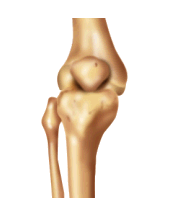The Knee joint, like the elbow joint, is a hinge joint. It is formed between the bottom of the thigh bone (the femur), the top of the tibia (the larger of the two bones that make up the lower leg) and the kneecap. Besides the movement of bending and straightening the leg, there is a small degree of rotation possible when the knee is bent (try it on yourself) but not when it is straight. The joint is contained within a capsule which extends some way up the front of the thigh, and which is strengthened at the sides to produce ligaments which help to stabilise the joint. There are also ligaments within the joint - called the anterior and posterior cruciate ligaments - which both prevent too much extension or flexion. When the knee is straightened there is a slight degree of rotation of the femur or on top of the tibia. The anterior cruciate ligament prevents any further backward movement, and the knee is said to be " locked" - this increases stability. Between the bones in the joint there are flaps of cartilage called menisci, which act as shock absorbers in the transfer of weight. There is a small amount of synovial fluid secreted by the synovial membrane of the capsule which lubricates movement in the joint. Beside the ligaments the knee is stabilised by the muscles which act upon it - the quadriceps at the front of the thigh and the hamstrings at the back. | |||
 | This information is licensed for use by Wellbeing Information Systems Ltd ("WIS"), and protected by international copyright law. All rights are reserved. (email info@wisinfo.co.uk). |
